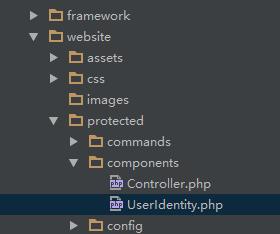Yii登录验证和全局访问用户ID
注意:Yii默认的代码,Yii::app()->user->id返回的不是我们想要的用户ID,而是用户名。因此在useridentity类中要用一个变量来存储登录用户的ID,然后重载getID()方法,返回正确的用户ID。
Yii 有一个内置的验证/授权(auth)框架,用起来很方便,还能对其进行自定义,使其符合特殊的需求。
Yii auth 框架的核心是一个预定义的 用户(user)应用组件 它是一个实现了 IWebUser 接口的对象。此用户组件代表当前用户的持久性认证信息。我们可以通过Yii::app()->user在任何地方访问它。
使用此用户组件,我们可以通过 CWebUser::isGuest 检查检查一个用户是否登陆; 可以 登录(login) 或 注销(logout) 一个用户;我们可以通过CWebUser::checkAccess检查此用户是否可以执行特定的操作;还可以获取此用户的唯一标识(unique identifier)及其他持久性身份信息。
为了验证一个用户,我们定义一个有验证逻辑的身份类。这个身份类实现IUserIdentity 接口。
不同的类可能实现不同的验证方式(例如:OpenID,LDAP)。最好是继承 CUserIdentity,此类是居于用户名和密码的验证方式。
定义身份类的主要工作是实现IUserIdentity::authenticate方法。在用户会话中根据需要,身份类可能需要定义别的身份信息。
下面是个例子:
class UserIdentity extends CUserIdentity { private $_id; public function authenticate() { $record=User::model()->findByAttributes(array('username'=>$this->username)); if($record===null) $this->errorCode=self::ERROR_USERNAME_INVALID; else if($record->password!==md5($this->password)) $this->errorCode=self::ERROR_PASSWORD_INVALID; else { $this->_id=$record->id; $this->setState('title', $record->title); $this->errorCode=self::ERROR_NONE; } return !$this->errorCode; } public function getId() { return $this->_id; } }
二、自己的操作
路径

<?php /** * UserIdentity represents the data needed to identity a user. * It contains the authentication method that checks if the provided * data can identity the user. */ class UserIdentity extends CUserIdentity { private $_id; /** * Authenticates a user. * The example implementation makes sure if the username and password * are both 'demo'. * In practical applications, this should be changed to authenticate * against some persistent user identity storage (e.g. database). * @return boolean whether authentication succeeds. */ public function authenticate() { $userInfo = Admin::model()->find('username=:name', array(':name'=>$this->username)); if($userInfo == NULL){ $this->errorCode=self::ERROR_USERNAME_INVALID; return false; } if($userInfo->password !== md5($this->password)){ $this->errorCode=self::ERROR_PASSWORD_INVALID; return false; } $this->_id = $userInfo->admin_id; $this->errorCode=self::ERROR_NONE; return true; /* $users=array( // username => password 'demo'=>'demo', 'admin'=>'admin', ); if(!isset($users[$this->username])) $this->errorCode=self::ERROR_USERNAME_INVALID; elseif($users[$this->username]!==$this->password) $this->errorCode=self::ERROR_PASSWORD_INVALID; else $this->errorCode=self::ERROR_NONE; return !$this->errorCode;*/ } public function getId() { return $this->_id; } }






